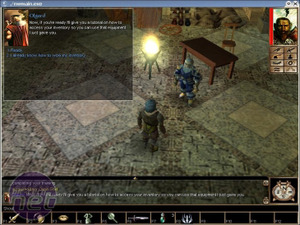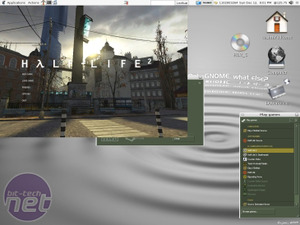Not-quite Emulation
First of all, let's get something straight. What most call an emulator, like Wine or Cedega, is in fact not even close to an emulator. Developers of such tools got fed up with it, and thats how Wine got its name - Wine Is Not an Emulator. Well, what is it then? It is simply a layer between the software program and the OS. The perception by most non-users is that this added layer adds a lot of slowdown. I must admit that that is true to an extent - the extra layer adds some latency, but efficiently written Windows programs will still run faster then poorly written Linux programs. The fact is that most Windows software will suffer a very small performance hit when running on Linux.Now, let's start at the beginning. Back in 1993, Bob Amstadt started writing on a piece of Linux software that would be able to execute Windows binaries. A year later, Wine was starting to take shape, and the world's most played game, solitaire, was already running inside a Linux environment. Things continued to improve, and soon more and more programs were working through Wine. In the beginning, the focus of the Wine project was to add as many programs to the working list as possible, rather than to get them work effectively. This was one of the reasons the Transgaming Cedega project fork saw daylight. However, Cedega wasn't the only fork that emerged, as CrossOver Linux by Codeweavers also got developed. Cedega went the gaming way, CrossOver went down the productivity applications lane.
Soon after the split, the Wine developers realised that more isn't always better (as a common Linux saying goes, “less is better then more”), so the team started to focus a bit more on efficiency. The fork also made the developers realise they needed to change their licensing - Wine changed from the X11 licence to the LGPL. This prevents Wine from going the way Cedega did. But even now, Cedega is even at this point closely related to Wine, with the two sharing very similar development paths.
Wine
Enough of the history lessons, what does Wine have to offer? While I can list a couple of titles that work through Wine, I'd rather explain how you get Wine to work. It might seem frightful at first to install Wine and get the extra layer going. However, it really isn't - Wine, as most applications, is often easily installed through the package manager that comes with any modern distribution. And what about driver support? Well, driver support in Wine is as good as driver support in Linux, which isn't all that bad and improving every day. Wine doesn't require any added configuration on the driver side of things, it uses the ones that are already present in the host operating system.

Wine running Neverwinter Nights and Counter-Strike 1.6.
But then how do I use Wine? Well, after initial configuration, using Wine is actually incredibly easy, even straight from the command line. You just issue the installer of the software program you want to use, prefixed with wine. So, if in Windows you would double-click D:setup.exe, you just have to type 'wine /mnt/cdrom/setup.exe' and Wine will do its magic silently. Post-install, you just run the program through Wine in exactly the same manner. As you can see, using Wine isn't that hard at all.
Transgaming Cedega
While Wine does a great job at running most Windows applications under Linux, certain games sometimes just won't work. Call it bad programming, call it faith, but the fact is that some applications refuse to accept Wine. The guys over at Transgaming noticed this and used a hole in the X11 licensing to create a proprietary fork of Wine. But the developers didn't claim they invented the warm water, and initially called their 'version' WineX. Improvements over the original Wine were mostly DirectX support and an easy-to-use graphical user interface. The improved DirectX support (full DirectX 9.0c to be exact) means that more games run under Cedega than under Wine. The easy interface and premade configurations for each game ensure easy and fast installing.

Cedega running Half-Life 2 and Battlefield 2
Like Wine, Cedega runs on every Linux distribution available, so you aren't forced to use a specific distribution to play your games. Downsides are that Cedega isn't free, coming in at £3 per month or £33 per year. But for that relatively small fee, you do get updates and support for a huge list of games. Also included in Cedega is a system testing tool that verifies if your setup is good for the jobs at hand.
Which to use?
Well, this is actually an easy question. Try Wine, and if it doesn't work, use Cedega. Wine has the advantage that it's free. But some games just won't work, regardless of the amount of tweaking you throw at it. After you become so frustrated with the fact that Wine isn't up for the job, then it is the ideal moment to head over to the Transgaming.org Games Database to see if your game is listed. If it is, then you can subscribe for a month, get the Cedega program and engine, and play your brains out. If your game isn't listed, I'd still recommend getting Cedega for a month, and just trying it, to see if it works. My experience with Transgaming is that if they can't ensure 100% that it works, they don't list it, which is a good attitude if you ask me.
MSI MPG Velox 100R Chassis Review
October 14 2021 | 15:04











Want to comment? Please log in.